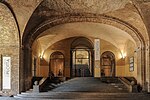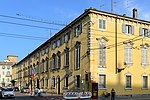Teatro Farnese

Teatro Farnese is a Renaissance theatre in the Palazzo della Pilotta, Parma, Italy. It was built in 1618 by Giovanni Battista Aleotti. The idea of creating this grand theater came from the Duke of Parma and Piacenza Ranuccio I Farnese. The theatre was almost destroyed by an Allied air raid during World War II (1944). It was rebuilt and reopened in 1962. It is, along with the Teatro all'antica in Sabbioneta and the Teatro Olimpico in Vicenza, one of only three Renaissance theaters still in existence.Some claim this as the first permanent proscenium theatre (that is, a theatre in which the audience views the action through a single frame, which is known as the "proscenium arch").
Excerpt from the Wikipedia article Teatro Farnese (License: CC BY-SA 3.0, Authors, Images).Teatro Farnese
Piazza della Pilotta, Parma Parma Centro
Geographical coordinates (GPS) Address External links Nearby Places Show on map
Geographical coordinates (GPS)
| Latitude | Longitude |
|---|---|
| N 44.804694444444 ° | E 10.325833333333 ° |
Address
Teatro Farnese
Piazza della Pilotta
43121 Parma, Parma Centro
Emilia-Romagna, Italy
Open on Google Maps











